In the ocean, time dependent tidal currents passing over topographic bottom features are a significant source of internal waves.18–22 In our model, the ocean is idealized as vertically unbounded medium and, since the source of the wave energy is at the bottom, all waves have upward group velocity and the radiated energy freely escapes to
. In this work we investigate the efficiency of mixing due to time dependent harmonic basic flow of the form
.Our model is includes Coriolis effects. Although the presence of an oceanic free surface is also significant.23 perhaps more so than rotation, we note that if we assume that waves generated by the topography are dissipated before returning to the bottom after reflection from the free surface, our solution will be of physical reference to the real ocean see e.g.,.6 where reduced mixing efficiency arising from boundary-layer physics is actually claimed.24.–26
A simple linear solution for flow at constant velocity and constant stratification over a Witch of Agnesi-shaped mountain of height H and half-width
(in our model, we consider the same form of corrugation) has been investigated in.27 The current knowledge of flows over hills is summarized in.28–30 and.19 The tides have been reexamined in.31 as a possible source of energy for diapycnal mixing in the ocean interior. Evidence from satellite altimetry indicates that as much as 30% of tidal dissipation occurs in the open ocean.32 a process previously thought to occur almost exclusively on the continental shelf. Much recent activity has therefore been focused on understanding where and how this open ocean component of tidal dissipation occurs.5,13,23,29,33–34 Previous studies of internal wave generation by flow over topography have identified two important controlling parameters see e.g..13,36 The first parameter
is a measure of the relative steepness of the topography, where the bottom is at
with H being the depth, and
(1)
is the slope of an internal wave group velocity characteristic. Here we use customary notation (see e.g.37 in which k is the horizontal wavenumber, m is the vertical wavenumber, ω is internal wave frequency, f is the Coriolis frequency, and N is the buoyancy frequency. As has been pointed in.13 it is most likely that the most efficient mixing is resulting from the reflection of an internal wave from a slope at values α close to its critical angles αc for which tan αc given by (1). The second parameter is
where L is topographic length scale. This parameter is a ratio between the tidal excursion distance
and the length of the topographic feature. It is one measure of nonlinearity. A third parameter is
where αis the topographic amplitude and H is the water depth away from topography.
Bell.33 considered the process of internal gravity wave generation by simple harmonic flow
of a stratified flow over an obstacle. His analysis was for an infinitely deep ocean with thee-dimensional topography h(x,y) in the limit
with finite
see e.g..13,36 Bell's model linearizes the problem by applying the boundary condition at z = 0, as we do here in a rotated three-dimensional coordinate system, rather than at the bottom topography
(we show later that , in an appropriately rotated coordinate system, we can linearize the problem about z = 0 as in Bell paper although, originally, the bottom is at
). Balmforth et al.38 have extended Bell's theory to steeper topography
but their linearization is justified provided that
i.e., the tidal excursion is much less that the scale of the topography. Khatiwala.23 in part based on Bell.33 examines the problem of internal wave generation by the interaction of an oscillating tidal flow with two-dimensional bottom topography
z. Unlike Bell's theory, which is applicable for a fluid of infinite depth in which energy input at the bottom radiates upward, Khatiwala imposes an upper rigid lid boundary condition resulting in a horizontal energy flux. Thorpe.39,40 extended the wave generation problem to uniform flow along a corrugated slope. His solution includes the effects of the earth's rotation and he considered corrugations that are at an angle to the direction of steepest slope. MacReady 4 Pawlak.41 presented an alternative derivation of Thorpe's solution (neglecting the effect of rotation) and extended it to flows above and below the low speed cutoff. Legg.13 performed numerical experiments for internal tide generation for a continental slope characterized by ridges and valleys running up and down the slope. Other related studies by Kunze.42 and Nash & Mourn.43. have considered internal tides on the continental slope and internal hydraulic flows on the continental shelf , and their results are not directly applicable to the deep ocean processes considered here. The process of generation of internal waves due to tide/topography interactions associated with oscillating along-isobath currents impinging on a ridge running down a slope with an inclusion of large tidal excursion to generate harmonics has been considered in Ibragirnov.44 The experimental work confirming some of the analytic predictions from.44 have been reported recently in.45
Here we focus on the corrugation scales and the effects of rotation on the energy flux in the vicinity of the critical slope
. Additionally, we also analyze the effects of concavity of the corrugation on the resulting energy flux which has not been analyzed in.44 Thus this work combines that of.43 for harmonics generated by large tidal excursion over weak topography (small-amplitude
gentle subcritical slope
) on a flat bottom with recent extensions on a slope.39,41
Governing equations
For the sake of definiteness, we set the axes as:x/ (assumed eastward),y/ (northward) and /
is the unit vector in the vertical z/ direction, opposite gravity
is the unit vector in the vertical
direction, opposite gravity (see (Figure 3) for the topographic coordinates). The fluid velocity is
= (u, v, w) relative to the Cartesian coordinate system (x',y',z'). Within the Boussinesq approximation, the governing equations of motion for internal waves, observed in a system of coordinates rotating with angular velocity
are written in the vector form as follows (see e.g.28
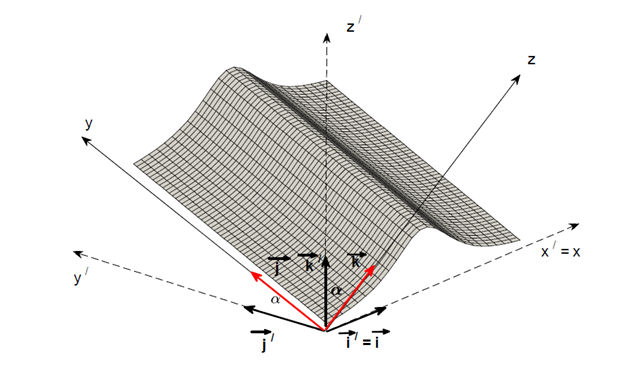
Figure 3 Corrugated slope sketch. To accommodate a sloping ocean floor, the model is considered in the system of coordinates rotated about the x axis by the slope angle a, so that in the new coordinate system the y—axis is directed upslope and z is perpendicular to the slope.
(2)
(3)
(4)
where g is the acceleration due to gravity so that p and ρ are to be interpreted as the pressure and density departures from their mean state
(5)
in which
is the constant reference density,
is a background stable density profile with the associated buoyancy frequency N defined by
(6)
and we require
and
to be consistent with the state of rest, i.e.
(7)
The quantity N, which is assumed to be a constant in the frame of the present study, measures the degree of density stratification of a fluid with average potential density
and thus represents the frequency with which a vertically displaced fluid element would be expected to oscillate because of restoring buoyancy forces.
The traditional f —plane approximation is made whereby we take
where f is the inertial frequency which depends on the rotation rate of the earth (angular velocity
).
The oscillatory three-dimensional time-dependent background flow over a uniform flat slope z = 7y is given by
(8)
where
the cross-shelf velocity U0 is assumed to be constant and w0 the frequency. Since we are mostly interested in tidal flows, hereafter we consider flows forced at M2 tidal frequency,
(9)
Thus the oscillating flow (8) is driven by the barotropic tide.
Since waves are generated not only at the fundamental frequency but also at all of its harmonics
less than N, our analysis will include, in general, an infinite number of discrete internal wave modes satisfying the dispersion relationship for internal waves. However, we will be interested only in the radiating part of the solution so that the mode numbers will be limited. Small perturbations are introduced:
(10)
where
is a small parameter.
Formulation of the main result
As has been shown in.44 in the system of coordinates that is moving with the background flow
and that is rotated about the x-axis by the slope angle α, the resulting non-dimensional, normalized time average power (energy flux) in the internal wave field, associated with the radiating part of the linearized model for small perturbations introduced by (10), is written as
(11)
where the following notation is used:
(12)
is the power input into the internal wave field averaged over the fundamental period
and
(13)
is the net force exerted into internal wave field due to the given oscillatory background flow in the vicinity of the bottom topography (see also.33). Also,
(14)
is the notation and
and
are the following nondimensional parameters:
(15)
in which k is a horizontal wave number,
is the Fourier Transform of the corrugation geometry h(x) that forces the motion, Jn, is the Bessel function of the first kind, and H and L are the horizontal and vertical scales of the corrugation h(x).
Since the generated waves are independent of the upslope coordinate y, the wavevectors must be in x, z plane. Two such vectors exist for sufficiently small α. Thus, as has been justified in.44 the radiating waves exist for frequencies
, where
(16)
(17)
where here.x means the greatest integer less that or equal to x. In particular, nN = 7 for
. If
or
the waves are evanescent. As follows from the dispersion relation (1), waves of frequency
, lying between f and N can propagate freely only for angles
(18)
which means that α is fixed by some harmonic of the high-frequency wave. This means that waves of frequency
, can exist only if the slope angle
is such that
(19)
As seen from (11), the normalized power
has a singularity in the in the vicinity of the critical angles
i.e. the singularity occurs if
(20)
which is the slope of an internal wave group velocity characteristic that has been identified in the Introduction by Eq. (1).
Remark: Radiating waves of frequency wn, do exist for angles satisfying the condition (19), so we write a
in order to indicate that the value of critical slope
is individual for each mode number n and latitude θ.
The most efficient mixing occurs in the vicinity of the critical slopes defined by (20), i.e. when a
. Thus evanescent modes do not contribute to F (t) because of upward radiation of energy. So, mixing occurs for those mode numbers n, that satisfy (16) and those angles
for which (19) holds.
To make some comparison with the Bell's results in.33 and to analyze the effects of rotation and the topographic scales on the energy flux studied in.44 we consider a specific example when the corrugation has the form
(21)
Our model is analyzed for the fixed value of parameters for which (15) yields
(22)
(23)
Since the parameter H does not appear in (11), without loss of generality we can set H = 1.
To analyze the resulting power input
, we first investigate the convergence of the integral
(24)
which is the approximation of the improper integral in (11) for M >> 1. Figure 4 is used to demonstrate the results of numerical simulations of
versus M at fixed values of ε. In our further simulations we use the values M = 10 and ε = 0.001.
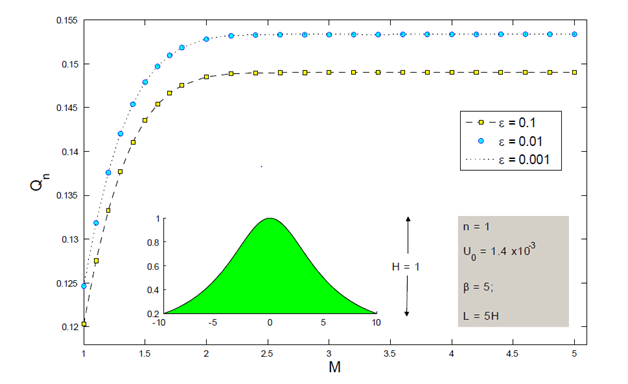
Figure 4 Convergence of the integral
as M→∞and ∈→ 0.
Figure 5 shows the results of numerical simulations for the normalized power (that can also be interpreted as a vertical energy flux)
without rotational effects as a function of slope
(i.e. purely equatorial waves as observed at latitude
North) for L = 5H and the fixed values of parameters λ and U0 given by (22). As we found earlier, the waves are nearly singular at the vicinity of the critical slopes
determined by the condition (20), which makes the energy flux increasing rapidly at the vicinity of
. This agrees with the suggestion of Legg, .36 about an efficiency of mixing in the deep ocean due to reflection of an internal waves from critical slopes. In particular, because of singular behavior
near the critical slopes
the visualization depends of stepsize of α. We further use the stepsize
. As we observe from Figure 5, the dominant contribution of energy distribution in internal wave field is due to waves of fundamental frequency with n = 1. We also observe the dramatic energetic drop at slopes of
but with subsequent "singular" increase at the successive critical slopes
, n > 1.
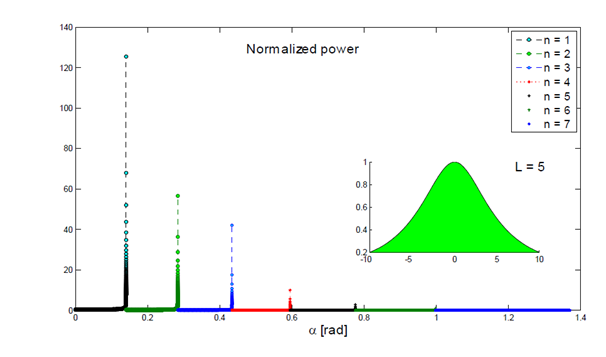
Figure 5 Vertical energy flux
as a function of slope a at latitude 0 deg North for L = 5 and stepsize
.
The effects of the topographic horizontal scale L on the normalized power
of the fundamental frequency n = 1 is demonstrated on Figure 6 in which the normalized power is evaluated at latitude
North (not affected by rotation). Additionally, Figure 6 shows that
for the same values of other parameters as been used in Figure 5. As we can see from the numerical simulations presented in this figure, as L goes from 1 to 50, energy monotonically decreases. However, the energy drop is not significant.

Figure 6 First mode normalized power at latitude 0 = 0° North as a function of the characteristic horizontal scale L of the corrugation in the vicinity of α =
The effects of the topographic horizontal scale on the normalized power
for all admissible harmonics without rotation (i.e. n ε.1, 7,
North) is also demonstrated on Figure 7 which illustrates the qualitative behavior of
versus slope α. For better visualization purposes, we use the "fill" option, set ε= 0 and use a larger stepsize
. As we observe , the higher harmonic waves gradually die off from the wave field for larger values of L. We also remark that, although the maximum values of the normalized power
look the same for smaller and larger values of L, in actuality it is not quite true; similarly to the observations made in Figure 6 for n = 1, there is an insignificant drop of energy for all admissible modes n.
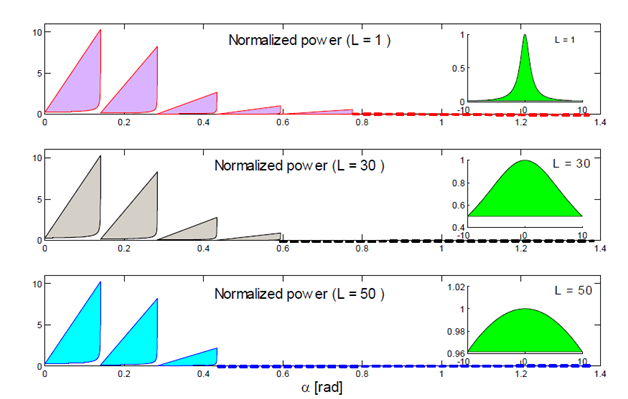
Figure 7 Qualitative energy analysis as a function of slope α at latitude 0 deg North with ε=0 and step size
.
Figure 8 is used to show the results of numerical simulations for the normalized power
versus α for all admissible modes n at latitude
North for L = 1. For better visualization purposes, again we use the "fill" option, set ε = 10–5 and use the stepsize
. The more detailed behavior of the first-mode energy in the vicinity of the critical slope
is shown inside the same figure. As Figure 8 shows, the energy attains its maximum not exactly at
but at some value
such that
. Because of singularity, we cannot evaluate the energy at the critical slope
itself, so we associate the critical slope, say
ctrl, which is reasonably close to
.

Figure 8 Eenergy flux at latitude θ = 10° North with L = H. Here we set ε = 10-5 and stepsize
.
Next, we investigate in more details the effects of rotation and the concavity of the topography on the resulting energy flux at the vicinity of the critical slopes
. Figure 9 is used to present the results of numerical simulations describing the behavior of the first-mode normalized power
versus for different values of latitude θ at the vicinity of
. We can see from these plots, that for the given value of θ, changing of the horizontal scale L does not affect appreciably the power
.However, for the fixed value of L, changes in latitude, have a noticeable impact on the power; not only on the numerical value at the vicinity of the critical slope
, but also on the concavity of the curve, that describes the power. Similarly to the results shown in the detailed plot of Figure 8, we observe here that the energy attains its maximum not at the critical value of the slope but at some value
. For example, when L = 5, we find that: at θ = 5°, the critical slope is approximated by
whereas the energy attains its maximum at
so that the difference between these two points is not zero and can be approximated by
. Similarly, at latitudeθ = 10°, we find
and
so that
.

Figure 9 Analysis of the points of energy maximum
and the approximation of the critical slope (i.e. the first zero
) for the first-mode of the normalized power at different values of L and latitude.
Figure 10 shows (here, again, we use the "fill" option) the normalized power
versus a for different values of latitude θ and different values of the horizontal topographic scale L. In particular, we use L = H (upper panel) and L = 50H (lower panel). As has been demonstrated earlier in Figure 7, we observe the gradual disappearance (dying off) of higher harmonic waves for larger values of L. In addition to the "dying off" phenomena, we observe that rotation tends to decrease the overall amount of radiating energy. So, we conclude that increasing the both latitude θ and the horizontal scale L lead to the decrease of the mixing efficiency and removing the higher harmonics waves from the radiating internal wave field. Here we set
and stepsize
.

Figure 10 Effect of rotation on the energy flux at different values of the horizontal corrugation scale L
As an illustration to the latter conclusion about the effects of rotation, Figure 11 shows the overall behavior of the normalized power versus a at fixed horizontal scale L = 5H and different values of latitude. In this particular example, shown in Figure 11, the normalized power at latitude θ = 10° North is plotted by red dashed line and the power at latitude θ= 40° North is plotted by a black pointed line. Here we set ε = 0 and stepsize
. Finally, Figure 12 is used to visualize the effects of rotation on the resulting first-mode energy flux versus α for different values of latitude and the fixed horizontal topographic scale L = 5H at the vicinity of the critical slopes
. It is similar to the plot shown in Figure 9 but with the larger latitude range. We can see from this list of plots, that the concavity of the curve, that describes the power, is more affected at smaller latitudes, somewhat in the range
North but for larger values of latitudes, the concavity of the curve is not changed. Here we set ε= 0 and stepsize
. For example, in panel (b) we find:
and
so that
. In panel (c) we find:
= 0.1046 and
= 0.047 so that
.

Figure 11 Comparison of the normalized energy flux at latitude θ = 10° North (red dashed line) with the flux at latitude 0 = 400 North (close to critical latitude, plotted by a black pointed line) at the fixed value of L = 5.
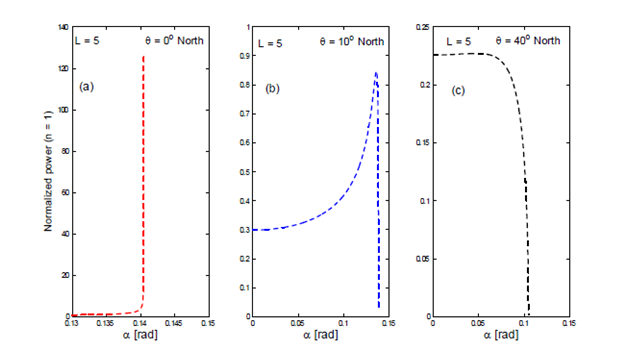
Figure 12 Analysis of the points of maximum
and the first zero
for the first-mode of the normalized power at different values of latitude and fixed value of L = 5.
We have investigated the effects of the Earth's rotation and the scales of the given corrugation profile h (x) on the efficiency of mixing associated with the radiating internal wave field that results from the reflection of an oscillatory background flow off a three-dimensional bottom topography, which is used to model a continental slope as shown in Figure 14. The continental slope is modelled by a corrugation given by h (x) running up and down the slope, which is shown schematically in Figure 13. It is shown that the most efficient mixing occurs in the vicinity of the critical slope given by
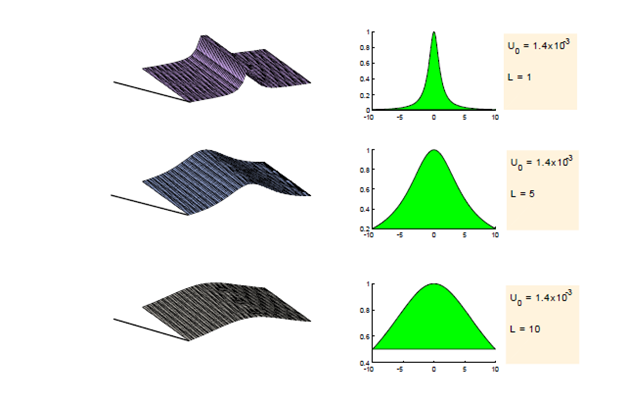
Figure 13 Schematic showing different horizontal scales L of the corrugation geometry.
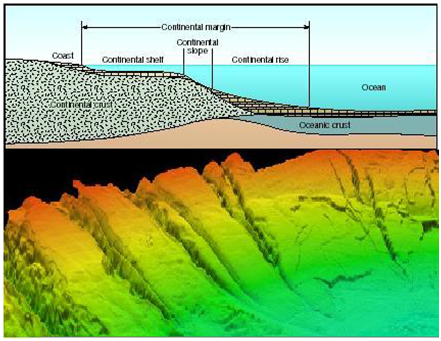
Figure 14 Upper panel: Schemtic presentation of a continental slope representing the submerged border gradually decreasing to the ocean bottom.
Lower panel: Bird's-eye view of continental slope and rise near Hudson Canyon. Note the landslide head-scarps and lobate deposits along the rise. Image source: NGDC.
(25)
which is in agreement with the suggestion of Legg,.36 However, more detailed analysis shows that the radiating part of the energy attains its maximum not at the critical value of the slope but at some value
. This fact has not been remarked in Legg.36 and has passed unnoticed in the previous studies in.44
It is also found that an increasing in the both latitude and the topographic horizontal L leads to the decreasing in the energy flux, particularly, we observed the gradual dying off higher harmonic waves for larger values of L. This means, that increasing the horizontal scale L leads to the decreasing of the value of the slope
beyond which waves of tidal frequency are not generated. In addition to the "dying off" phenomena, we observe that rotation tends to decrease the overall amount of radiating energy.
We believe that, from physical point of view, the observed "dying off phenomena can be explained by means of the previous relevant results in MacCready 4 Pawlak.41 according to which, for the values of slope α exceeding the critical value, the fluid parcels do not have enough energy to go over the topography so that the fluid currents are trying to go around the topography.
The interest to this work has been motivated by the increasing interest of oceanographic community to the overpowering amount of untapped energy that is contained in the ocean, and especially in its coastal regions having a complex bathymetry, particularly the prominent corrugations, of the continental margin. It is well recognized that ecosystems are defined by a complex suite of interactions among organisms and also between organisms and their physical environment; a disturbance to any part may lead to cascading effects throughout the system. Ocean mixing has an impact on marine ecosystems through a variety of pathways. Some of the most convincing evidence that a deep ocean mixing affects marine ecosystems comes from studying of effects of warming water on coral reefs. Coral reef ecosystems are defined by the large, wave-resistant calcium carbonate structures, or reefs, that are built by reef calcifiers. The structures they build provide food and shelter for a wide variety of marine organisms. Additionally, it is now recognized that the ocean can produce two main types of alternative energy thermal energy from the sun's heat, and mechanical energy from the tides and waves.47,48 However, we are unaware of any theoretical, numerical or commercialized projects related to the available alternative energy due to internal waves in the coastal areas of the ocean.











